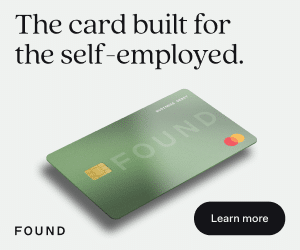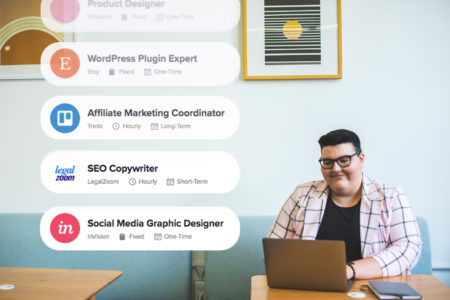Starting a graphic design business can be an exhilarating and exciting adventure whether you’re hoping to work for yourself full-time or just make a little extra money from an on-the-side design business.
And it’s pretty straightforward too if you’re willing to put in the work.
I’ve coached thousands of graphic designers over the last 10+ years through this blog, our podcast, and our mastermind group. So in this article, I’ll take everything I’ve learned after a decade of coaching to help you know exactly what to do to start a graphic design business. I’ve broken the process into 10 steps, which you’ll find below.

Get Weekly Freelance Gigs via Email
Enter your freelancing address and we'll send you a FREE curated list of freelance jobs in your top category every week.
- Always start with finding clients—never anything else.
- Develop a solid business plan that includes your pricing structure, marketing strategy, and financial projections.
- Build a strong online presence and create a professional portfolio that showcases your skills and expertise.
- Establish relationships with other designers, freelancers, and industry professionals to build a strong network and generate referrals.
- Focus on providing exceptional customer service and building positive relationships with clients to ensure repeat business and ongoing success.
1. Find your first graphic design clients
You might find it surprising, but my first step is to secure design clients.
What about crafting your portfolio, deciding on a business name, or obtaining a business license, you might ask?
Indeed, these elements are crucial.
However, I’ve observed many designers get lost in these preliminary tasks and burn out before they even engage with potential clients. Initiating a graphic design venture can become daunting if you start with the minutiae of business operations.
Therefore, we’ll kick off your design business on a positive note by securing your initial design clients. Once you have a few clients ready to compensate you for your work, you’ll be amazed at the surge of excitement, energy, and drive within you.
With this newfound momentum, you’ll find yourself well-equipped to address the remaining tasks.
Therefore, goal #1: find graphic design clients.
Where do you find graphic design clients?
If you’re a beginner at small business, you might be asking yourself: Where can I even begin to find my first design clients?
Lucky for you, finding graphic design clients has literally never been easier. There are hundreds of freelance job sites around the web to help you find exactly the kinds of clients you’re looking for.
For example, sites like Fiverr offer a huge marketplace of entry-level clients that can get you started when learning how to start a graphic design business. These most likely aren’t the kinds of clients you want to work with forever (although some may be), but they’re a great way to get some experience, a few portfolio pieces, some cash, and some confidence.
You can also find some nice entry-level work on sites like Upwork. Upwork is one of the most popular freelance marketplaces in the world and you’ll find access to thousands of graphic design jobs there.
To take action: here are 2 of our favorite sites to find design clients fast:
SolidGigs
SolidGigs’ team of fellow freelancers combs through thousands of freelance job boards every weekday and posts the very best leads to your custom inbox.
You can learn more about SolidGigs here.

Upwork
Next up is the largest freelance services marketplace in the world (at least I think it is). It’s called Upwork and lots of freelancers have built their own six-figure businesses on the back of this powerful platform, including this guy.
In the beginning, don’t be too picky
When you’re in the early stages, you might encounter seasoned freelancers and “experts” advising you to be choosy about your clientele.
They can afford such selectiveness, can’t they? After all, they’ve been at the helm of their small businesses for years, with client acquisition now a routine matter for them.
But you? You’re in immediate need of graphic design clients.
In the beginning, it’s wise to accept any reasonable graphic design work at a fair price. The potential of these initial projects is often underestimated.
At the very least, they’ll furnish you with confidence, experience, and valuable additions to your portfolio. In the best-case scenario, they might evolve into enduring, profitable business connections or serve as gateways to additional clientele.

Your client roster can be refined over time. However, for now, avoid being overly selective to the point where your graphic design venture never takes flight. This very trap has led to the downfall of many aspiring designers.
2. Set your pricing
Now, let’s dive into the topic of your pricing structure.
Are you thinking of billing your clients on an hourly basis, per project, or according to the value you provide?
For those just beginning, hourly rates are straightforward and quite prevalent, but you might consider other pricing strategies as you gain more ground.
Figuring out what to charge graphic design clients
Deciding on your rates can be daunting. To assist, we’ve developed a complimentary calculator to help pinpoint your ideal charge.
But let’s be real—if you’re at a complete loss about your rates, just pick a starting point. Should a prospect hesitate at your quote, you might adjust downward slightly. Conversely, if there’s no negotiation from the client’s side, consider increasing your rate for the next project.
You’ll eventually find a sweet spot for your pricing. Make it a habit to reassess your rates regularly. You might be surprised at how much you can command as you progress.

3. Name your graphic design business
With a few clients under your belt and the confidence for the long journey ahead, it’s time to establish the foundation of your solid small business, beginning with a thoughtfully chosen business name.
Deciding between using your own name or creating a business name
A common initial query for anyone starting in graphic design might be:
“Should I use my own name, or should I craft a unique business name?”
The straightforward answer is: it’s not overly critical. Choose something that resonates with you. Remember, you can always opt for a change down the line.
Delving deeper, the decision warrants some consideration.
While my suggestion is to select a name and forge ahead (bearing in mind that changes are feasible, albeit not ideal, but certainly manageable), the process of choosing your graphic design business’s name might necessitate more deliberation.
The name you settle on can influence various aspects of your design business, such as:
- Your potential to command higher rates for your design work.
- The ease with which people recall your brand.
- The type of design projects you’ll attract, including the industry, quality, and magnitude.
- The likelihood of being recommended by others.
- Your legal ability to operate without violating copyright or trademark laws.
- And much more…
My top advice for naming your graphic design business
To keep the process straightforward, here’s my prime piece of advice for naming:
Prioritize simplicity: ensure it’s easy to pronounce, remember, and spell
It’s tempting to get overly intricate, witty, or inventive with your design business’s name. Instead, aim for simplicity. Your business name should be easily articulated, spelled, and recalled by potential clients.
Make sure it’s available on the web
Before you fall in love with any name too much, you should check its availability around the web. Are the social media channels you hope to use (if any) available? Is there a domain that works well for your design company name?
In order to keep your ideas safe from domain squatters use something like Bluehost or Dreamhost to check domain availability without risking it being parked or squatted.
Ensure you personally love it & it speaks to the vision of your company
While I really don’t want you to get paralyzed by the task of choosing a domain name (see the next point) it’s also critical that you feel good about your name and it speaks to the vision of your graphic design business.
You’re going to have to say the name of your business a lot. You’ll have to type it. You’ll have to speak it out loud. And if you feel silly about it or have to explain the context or feel the need to pronounce it for people, that’s going to get old really fast.
Don’t get paralyzed by decision
The biggest error I see people make in this regard is getting stuck on all the possible graphic design business names that are available.
The ultimate enemy here is indecision. Because while this is an important decision for your business, getting back to the revenue-driving decisions is far more critical at this stage.
For more help, you can also download my business-naming workbook which will walk you through an easy-to-follow process for naming your design business successfully.
4. Build a basic website
The next step is to build a basic website. I say basic because, just like naming your design business, it’s easy to get stuck or paralyzed by the seemingly overwhelming task of building your website. That’s why you can use an AI website generator to speed up the process of designing a website but if not you can use other tools.
Lucky for you, there are loads of very easy-to-use and affordable website builders to build your first portfolio website.
My top beginner website builder recommendations
Here are my personal top picks. None of them requires you to learn to code and they’re all affordable.
- Wix is an easy-to-use website builder with hundreds of beautifully designed templates to choose from—all with drag-and-drop functionality. They’ve even got quite a few portfolio-centric options to get you started.
- WordPress may require a little bit more technical know-how (still no coding required) but it definitely gives you more flexibility in the long run. And because it continues to be the most-used website builder on the Internet, there are millions of tutorials to help you if you get stuck.
- Pixpa is designed specifically for creatives and includes cool add-ons like a client-proofing area or a simple gallery feature.
The “minimum viable” portfolio site
For years, I have preached the importance of what I call a minimum viable portfolio.
As a designer you care very much about how things look, making it far too easy to overdo things, keep adding more and more, editing, adjusting tweaking.
Which often leads to never publishing your portfolio. Which means no clients. And no graphic design business.
The better path (the one I hope you’ll take) is to aim for a “minimum-viable” portfolio.
The term “minimum-viable” answers the question “what is the least I can do to prove my portfolio can generate sales?”
Then start with that. It doesn’t mean, as you grow your business you can’t revisit your site and optimize it for getting more clients? You can. And you should.
For now, your mission is to learn how to start a graphic design business and get it off the ground. All the fancy stuff can come later once you have revenue coming in.
5. Develop a simple business plan
Once you’ve got a few clients in the door, you’ve named your business, and you’ve got a minimum-viable portfolio site, you can finally start thinking more strategically about how to start a graphic design business the right way.
In my experience, the best next step is to develop a business plan.
Why isn’t that the first step on the list? Because I didn’t want you to get stuck forever in the “planning” stage only to never actually make it to the executing stage. Far too many design businesses (and businesses of all kinds) get lost in the planning stage and never see the light of day.
But not your design business. No. You are going to be different.
You only need a very basic business plan. In fact, it doesn’t need to be more than one page long. You can follow our freelance business plan template here and fill it out in less than 30 minutes.
For an even shorter business plan, grab a piece of paper or a computer and answer the following questions:
- What services will my design business provide?
- Who is the ideal client for my graphic design business?
- How much will my design business charge for the work I do?
- What are your monthly design business revenue goals?
- How many clients do I need each month to hit my revenue goals?
- Where/how will I find new design clients? Or how will I retain current design clients?
Answering these and similar questions will help you maintain traction and gain momentum when getting started.
6. Communicate with your clients
One thing you’d find out extremely quickly is you have to wear a lot of different hats. Not only are you a graphic designer, but you’re also the bookkeeper, the marketing manager, and the account manager.
Communicating regularly and effectively with your clients is an absolute must. Luckily, you can interact with them in various ways; some examples are phone calls, emails, direct messaging on social media, and webinars.
Make your lines of communication open to nurture leads and clients. You can set up a toll-free number or a business email to make your graphic design business look more professional to prospects. Remember that addressing client concerns outright with a positive approach is key to good customer service.
If you want to exercise good communication, keep in mind that the clients are the people who keep your business afloat. The freelance designers who I see succeed the fastest are the ones that realize their clients aren’t some burden they have to deal with, but an essential and wonderful part of their graphic design business.
If you find yourself overwhelmed with all the client communication, try using a CRM tool to keep track of all client interactions.
7. Deliver high-quality projects on-time
If being unprofessional in your communication methods doesn’t kill your business, then failing to deliver on your promises will.
This is another huge fail-point for many designers because they mistakenly think the hardest work is finding design clients when in reality, it can often be more difficult to manage multiple projects and always deliver on time.
Project management tools can help you manage your projects and tasks, keeping you on track and ensuring you give your design clients a positive experience every time.
This can be especially important in the early days of your graphic design business since a few bad reviews or bad word-of-mouth reports around your local city could signify a real setback for you.
8. Write and send professional invoices
Once you’ve delivered your work to your clients and you’re ready to get paid, you’ll want to create and send a professional invoice.
The most basic option is to just write an invoice in Google Docs, Word, or InDesign and send it over via email. But I recommend eventually using a professional invoice tool—where you can create and send invoices quickly and efficiently.
Plus, using tools like these mean your clients can pay directly from the invoice when they open it on their computer. And, if after a while, your client forgets to pay the invoice, many of these apps will remind them for you automatically.
9. Collect payments from your design clients
When you’re first learning how to start a graphic design business, the idea of doing work you love every day can be exhilarating.
In fact, depending on how much you hate your day job, you might be hoping this business can be an escape from your cubicle into work you actually care about. But if you get so caught up in the day-to-day creative work that you forget to manage your business properly, you won’t be in business for long.
Indeed, a business that doesn’t generate income essentially remains a hobby, underlining the paramount importance of securing payments.
Easing the Awkwardness of Payment Collection
Requesting payment can feel uncomfortable, particularly for those new to the business world. To mitigate this discomfort, consider two straightforward strategies:
1. Normalize the Payment
It’s essential to recognize that exchanging money for services rendered is a standard business practice, occurring daily across various industries. Launching a graphic design venture is no exception.
Your clients routinely pay for services, whether it’s shipping costs with FedEx, electrical repairs, or even the weekly office donuts. It’s all part of conducting business. By treating payment collection as a routine aspect of your operations, you’ll help normalize the process for both parties.
2. Simplify the Payment Process for Clients
Difficulty in receiving payments might indicate a cumbersome payment process for your clients. Given that people often juggle busy schedules or may procrastinate, simplifying the payment process can significantly benefit both you and your clients.
Employing an online payment tool that facilitates direct bank transfers can streamline transactions. As your business evolves, you might consider setting up recurring invoices or securely storing client credit card details for seamless future payments.
With more experience, you could even prioritize payment collection by requiring it before delivering the final product. This approach can prevent protracted disputes or the hassle of pursuing overdue payments, though it’s advisable to adopt this practice once your business is more established.
10. Ask for referrals
No matter how many times I ask business owners what the most common way of getting new business is, I always get the same response:
Asking your graphic design clients for referrals can be a really great way to establish yourself. If you’re not sure where to get started, you can download our referral-generating email template.
But asking for referrals for your graphic design business shouldn’t be awkward or difficult. In fact, with a lot of practice you might even get good enough to ask for referrals throughout your process without ever blatantly begging for them.
Remember, part of the challenge of learning how to start a design business is ensuring you have continuous design work every month (not just this month) and referrals are a fantastic way to keep the client pool full.
This brings me to my last (unofficial) step in this process:
Repeat steps 5-10 regularly in order to grow
If you want your graphic design business to grow, you’ll need to constantly be making adjustments to your pricing, your client communications processes, your invoicing habits, and lots more.
That’s the fun of building a small business.
It’s like any great design project: it takes a lot of brainstorming, tweaking, adjusting, and refining. It’s a lot of hard work.
But you can do it. I know you can. And we’re here to help. Subscribe to our newsletter and join our FB mastermind group for added support and we’ll help you wherever we can along the way.
Keep the conversation going...
Over 10,000 of us are having daily conversations over in our free Facebook group and we'd love to see you there. Join us!




This is a very helpful article. It covers all the questions and doubts every beginner has.
Great Guide Greer!
Starting a new business …it’s not an easy task but you have written what exactly required to start a design business.
All these things are matter but the main thing is to know how the successful business owners like to shape the plans. We should check their footprints and follow –up them.
I think the best business plan is your words….
Keep up the awesome work!!!
Great and helpful blog to everyone. Thanks a lot for sharing this amazing article.
Hi April,
I’ve started freelancing a few months ago and a lot of what you wrote resonates with me. Especially the bit about finding good clients that you work well with.
I was also curious about how you get briefs from your clients. Do you have a template you get them to fill out or do you work with what they give you? I have recently found myself doing a lot of extra work which I feel is not on the initial brief but some how my client feels it is. It’s especially around brand ID stuff. Dose anyone find this difficult as well? Do you have any tips how I can ease my pain? Especially when there are multiple stakeholders in place who all feel like they require sign off, on every aspect of things.
Thank You!
Thanks for this, also i really appreciate those tools you recommended
thank you so much ,it helped me!
Very helpful .Thanks for sharing ☺
Hello April, I found this article very helpful! My question for you is what assets if any should I look forward into investing in, for example should I invest in some sort of printing machine, certain computer programs, scanners, etc.
Fantastic resource!
Structuring your business for taxes
When was this article published?
Great article! I really enjoy read each of sections. I only did a few of these aspects for my business, and i think i would add these steps to my business.
This was extremely helpful. Starting your own business is a daunting task and by breaking it down for viewers in such an organized and insightful manner is inspiring and palatable. I feel so inspired and motivated to begin.
i am totally agree with your all point. For me, one of the hard work is finding a reliable client for design business. I am enthusiast to follow your guidelines. Hope it will working for me to find few more client.
this article is very useful and have inspired me. thanks!
I wish everyone read this post before they startup.
How to make a proper portfolio for design and web firm. It would be great if you can send me some samples/
Very useful article thanks
Thank you for this great article, I like it, it’s very practical.
Great article
To tell about Web Design like producing a two Web pages can be skilled by just about anyone, but to build a self-sustaining work one needs the right tools, planning,training and experience. http://goo.gl/fsRNBT
Some great advice here. I have recently started my own Graphic and Design and Illustration business at http://nylelevi.com.com
Please take a look if you are interested in seeing what I do. You may even pick up some tips on how to present yourself online if you are planning to start your own business soon.
5 star on this one. copy/paste to clip board 😉
good ideas when you have enough capital
Great tips.. They can be applied not only to design business but to other kinds of businesses too.
I want to start my own business doing design
me too. Hope its moving forward for you. Reading this article and comments on my 9 to 5 London commute has made me think hard about next steps. I’d love to set my self up, just need to take the plunge i guess with lots of positive affirmations, 🙂
I started http://2cooldesign.co.za in 2005 and have never looked back, I’m always looking for more work. Want to be inspired, come see my awesome portfolio, Recommend me to your friends, please & thank you for taking a look ! All the best Guy Tasker creator of 2cooldesign.co.za Awesome Graphic design company based in South Africa. Online based Business, I work from home 🙂
Excellent article. Starting any business can be difficult, but if your passionate about what you want to achieve, it’s possible. It’s also advisable to participate in forums , you can learn and network with other professionals within the industry.
I fully agree with Mel on the emphasis upon work and letting it speak for itself. Also, as Kristine puts it, referrals are an essential customer-base but winning them requires a happy client network that will spread your word. Alongside putting up a team of incentive-driven, passionate & like-minded people, is something that greatly helps in the long run. They bring ideas, networks, energy and add a lot of support. Five year vision, six monthly targets, professional advisers, masters of business administration, etc. are sure-shot recipe, I feel, to bog down budding entrepreneurs, but become necessary when external opinions (investors, shareholders etc.) are unavoidable.
Hmmm…
Great info!
On a side note, as I have learned from several business owners, clients are important, and so is marketing, but if you are good at what you do you really don’t have to spend as much time and cash on advertising as you think. Referrals help, but can and does give your client the impression you are looking to expand or take the focus away from them. It just needs to be tastefully done.
I’m thinking an infographic on the best ways to ask for a referral??
Otherwise this content is good. It seems a little heavy, as far as getting exposure etc, and simply to make money, but in my experience I’d rather focus on the work then what I’m trying to achieve financially (at least this is how it comes across) because if you’re good at what you do money will come 🙂
From my own experience, for a business the most important thing is Clients and Cash. Enough Cash at hand to keep rolling till Clients start filling in Cash and repeat. While most of your points address the Client angle, none of the points actual talk about Cash, for a new startup business keep the Cash register ringing is equally important 🙂
Good one .
Great post, John! I would add that, along with the business plan, one should write a marketing plan. This plan should outline how the business owner will make the business plan a reality, from strategizing what to sell and when, to networking and proper utilization of social media. Without this supporting document, even the best business plan is just words.
Ah, #10! Can’t say enough about it….
I’m a believer in preframing for referrals. Each time I land a new account, I say to the Client, “I’m going to make you very happy. Your business will shine, you’ll feel like a rock star, and you will thrilled with the result. And when that happens, would you mind if I asked you to refer your colleagues/associates to me?” Of course, the response is always “I’d be happy to refer you – IF you impress me first!” Once the project is complete, I say to the Client “Remember when I asked you if you wouldn’t mind referring your colleagues/associates to me? What do you think, are you confident enough in my ability to send your friends or family my way?”
It’s a lot easier to ask for a referral when you’ve preframed your Client for it from the start. 95% of my work now is by referral/word of mouth, and I believe this is the reason. I rarely get a new client any other way anymore.